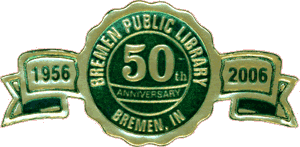

This article was published in the August 17, 2006 issue of The Bremen Enquirer and is reprinted here with their permission.
This fall marks the 50th anniversary of the Bremen Public Library, which was lauded with an open house celebration Aug. 19, 1956. In honor of this illustrious occasion, The Enquirer will salute the library with a three-part series dedicated to its evolution — from its earliest incarnation as something of a mail-order, state-run entity, to its present state as a modern, yet modest establishment and landmark.
By Amy Wenger
Enquirer Correspondent
BREMEN — Fifty years ago, a shining new portal guiding a path to boundless adventures awaited the townsfolk of Bremen.
By way of this window to wisdom, intrigued visitors could find a wealth of means to enlighten and enhance their minds and spirits. There were opportunities to escape to a fantasy land, become immersed in a realm of true tales or find education on virtually any topic that piqued one's interest.
This was the mission of the W.E. Walter Memorial Library, presented to the community on Aug. 19, 1956. And although the building itself, as well as the spectrum of materials housed within, has markedly evolved over the past half century, the original vision has not wavered. Furthermore, the unveiling of the simple but stately brick structure marked the culmination of a dream that took yet another half century to bring to fruition.
Long before the cornerstone was placed for the W.E. Walter Memorial Library, an announcement was ushered forth from the state of Indiana assuring that all residents would have the privilege to partake of "circulating libraries." The issue was discussed in detail in a Nov. 28, 1902 news release that found its way to the Bremen Enquirer.
"Everybody in Indiana should understand that provision has been made by the law by which the people in any locality in the State can have the benefit of free circulating libraries," read the story in part. The statute further described that the libraries carried no expense to the public, save for the minimal cost of circulating books to and from the capital city.
However, there were a few caveats: The regions to be represented were to form their own library association of five or more persons; a librarian was to be selected; and a gesture of guarantee had to be implemented for safe return for the books.
Public libraries of that era offered two genres of materials. There was the "general library," which consisted of 40 volumes featuring subjects such as fiction, history, biography, poetry and science among others. Then there was the "study library," focusing on topics beyond the mainstream, including agriculture, music, art and literature. Prospective patrons were offered a list of subjects and titles from which to choose, which was distributed through the Commission.
Though it took some time for the concept of a true community library to wend its way to the local level, that is precisely what happened in Bremen by the spring of 1925. The American Legion accepted the challenge of providing residents an outlet through which to visit and select books of their own volition. And so it came about that Bremen's first public library, located at the Town Hall, opened in March of 1925. The first librarian was Miss Edna Ellis, and she maintained that role for several years to follow.
Eventually, the town assumed responsibility for the tiny library and the distribution of books. A unique rental system was instituted in 1932, to help defray the costs of purchasing and upkeep for the growing collection.
As new books were bought in preparation to be added to the facility, they were available to rent, but they carried a small checkout fee. Once the charges had dwindled, then the books were moved to the "free shelves," at which point anyone could check out the items.
The monies collected in this fashion were also significant in that the library could continually purchase additional books. This mode of operation was further discussed in a presentation given to the Current Events Club by Mrs. Cleo Juday, an address which she called "Our Bremen Library." Juday shared her knowledge with the ladies during a meeting held in October of 1939. "As many as 661 new books have been purchased for the library with the money received in this way," she told the members.
At that time, Juday also noted, the library's shelves housed more than 2,000 books, the vast majority of which were reference books. The demand was rising for the offering of more adult fiction and more children's selections. There were 1,500 rural and town residents who were cardholders then, and the average number of books checked out per day hovered around 30.
But as there were obvious advantages to having a growing interest and inventory in the library, there was a downside as well — namely, lack of feasible space. The small room nestled at the town hall did not provide the proper flow to accommodate a large number of visitors, and there were no tables or chairs for patrons to simply sit and read. A solution would have to be warranted in fairly short order.
Later that same evening, the president of the Current Events Club, Mrs. R.H. Stoller, appointed a group of women to serve as a library committee, a liaison for public input and potential donations. That committee consisted of Mrs. Ernest Goss, Mrs. Ervin C. Foltz and Mrs. Henry Laudeman. The first act of business — to deliver 65 new children's books to the library.
The gathering of the Current Events Club on that autumn evening so long ago proved to be somewhat serendipitous. The chosen meeting place was at the residence of a lady whose name is certainly well recognized from both past and present — Mrs. William E. Walter.
Next week: Raising the Roof — The Campaign Begins